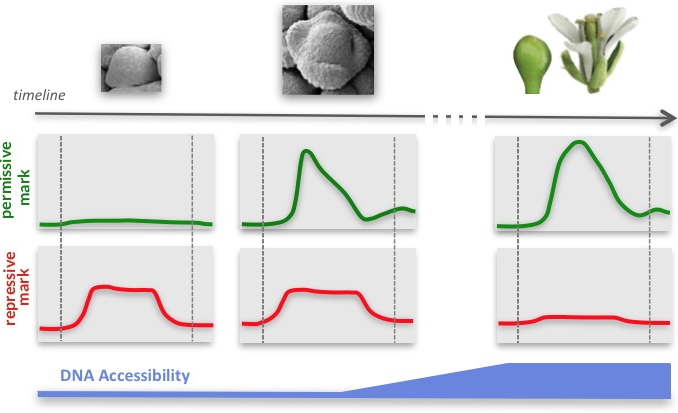The construction of a flower is fascinating: the four types of very different organs that compose it emerge from the same microscopic structure composed of stem cells, all initially identical. These cells acquire different identities by engaging in several differentiation programs, thanks to a selective reading of the genetic information contained in their nuclei. This differential and dynamic reading requires the perfect orchestration of a set of so-called "epigenetic" mechanisms.
The work of researchers from the
Floral Regulatorsteam[Cell & Plant Physiology laboratory] shed new light on these epigenetic mechanisms. In the nucleus of the cell, DNA is intimately associated with histone proteins to form the chromatin which, according to its conformation, renders access to genes more or less easy. This accessibility depends on the presence of permissive or repressive
epigenetic marks* (Figure). Cristel Carles and her collaborators studied the dynamics of these marks throughout the genome and at different stages of floral development in the model plant
Arabidopsis thaliana. The researchers decided to follow the dynamics of two key marks that play antagonistic roles in the regulation of developmental genes.
While these two marks are very dynamic during flower development, changes in the permissive mark are detected earlier than changes in the repressive mark. The changes in permissive marks are much more predictive for the expression of genes and coincide with the accessibility of DNA, whereas the changes in repressive marks rather follow already initiated expression changes.
These discoveries highlight the pioneering feature of an epigenetic mark in the regulation of developmental genes. They challenge the canonical models pre-established in animal stem cells, in which the decline in repressive mark conditions the expression activation of genes involved in cell differentiation.
The figure illustrates the chromatin dynamics that accompany the setup of differentiation programs during flower development (the analysed stages correspond to flower buds and blooming flowers, as represented in photos).
The graphs show the mean distribution of epigenetic marks on a gene subject to activation (vertical gray lines delimit the boundaries of regions carrying the genetic message). These marks correspond to a trimethyl modification carried by Lysine residues of Histone 3, either in position 4 for the permissive mark (H3K4me3, green curve), or in position 27 for the repressive mark (H3K27me3, red curve). DNA accessibility of the genes subjected to activation (in blue) is also presented. Changes in permissive mark prevail over those in repressive mark both for the activation of genes (this figure) and for their repression.
© Engelhorn et al., Epigenomes, 2017.
Epigenetic marks *: modifications carried by DNA or histone proteins, for example by addition of methyl groups. This work was funded by the ANR JCJC and the CNRS-UJF then IUA-UGA Chairs (Cristel Carles) and a grant from the Embassy of France and a Marie Curie FP7 scholarship (Julia Engelhorn).